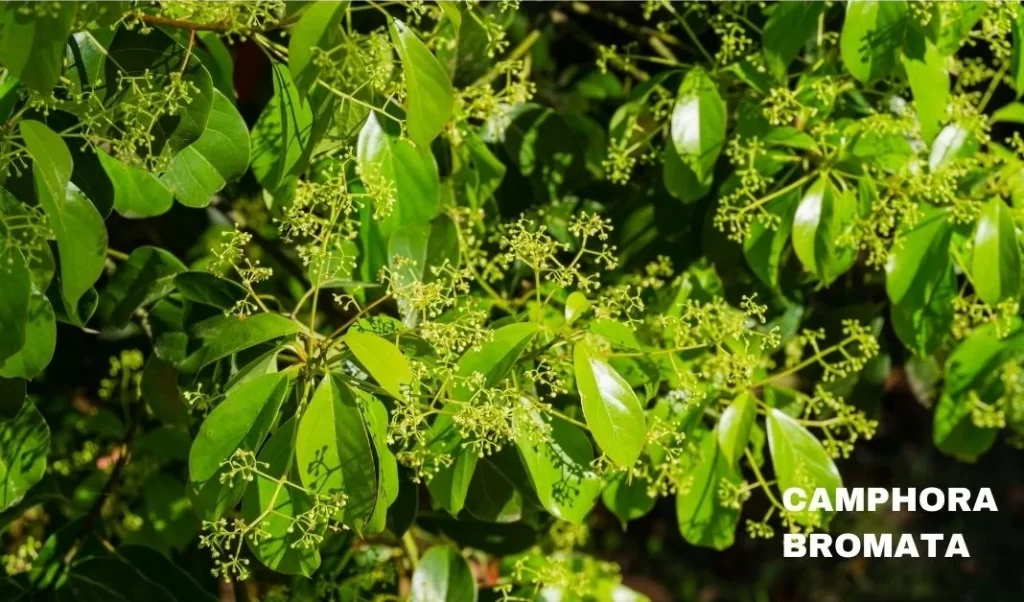Camphora Bromata, derived from the mono-bromide of camphor, is a homeopathic remedy primarily indicated for conditions of nervous excitability.
It is known to address various symptoms such as suppressed milk, nightly emissions, painful erections, paralysis agitans, cholera infantum, infantile convulsions, and its synergy with Quinine.

Table of Contents
ToggleSOURCE INFORMATION
Scientific Classification
- Kingdom: Organic compounds
- Family: Monoterpenoids
- Genus: Camphora
- Compound: Mono-bromide of camphor
Origin
- Camphora Bromata, also known as Mono-bromide of camphor, is derived from camphor, a white, crystalline substance obtained from the wood of the camphor tree (Cinnamomum camphora).
- The camphor tree is native to East Asia, particularly China, Japan, and Taiwan, and has been cultivated for centuries for its medicinal and aromatic properties.
- Mono-bromide of camphor is prepared through specific dilution and potentization processes in accordance with homeopathic principles.
Historical Background
- The use of camphor in traditional medicine dates back thousands of years, particularly in Asian cultures where it was used for its analgesic, anti-inflammatory, and antispasmodic properties.
- In homeopathy, the preparation of Camphora Bromata as a remedy involves diluting and potentizing mono-bromide of camphor to harness its therapeutic effects.
- Homeopathic practitioners have utilized Camphora Bromata for various nervous system disorders, reproductive system issues, and altered mental states.
Interesting Facts
- Camphor has a long history of use in religious ceremonies, traditional medicine, and as a flavouring agent in food and beverages.
- Mono-bromide of camphor is known for its ability to intensify the action of quinine and render it more permanent, making it valuable in the treatment of certain conditions like malaria.
- In homeopathy, Camphora Bromata is indicated for conditions such as nervous excitability, hysteria, altered mental states with trance-like states, suppressed milk, nightly emissions, painful erections, and infantile convulsions.
DRUG PATHOGENESIS
- Camphora Bromata primarily affects the nervous system, particularly in cases of nervous excitability.
- It addresses conditions such as hysteria, trance-like states, and peculiar mental symptoms like the reversal of directions.
KEY CHARACTERISTICS
- Effective for addressing nervous excitability.
- Addresses symptoms such as suppressed milk, nightly emissions, and painful erections.
- Indicated for conditions like paralysis agitans, cholera infantum, and infantile convulsions.
- Enhances the action of Quinine, making it more lasting.
PARTICULAR ORGAN SYMPTOMS
MIND
- Hysterical manifestations with alternating weeping and laughing.
- Perception of reversed directions, leading to disorientation.
REPRODUCTIVE SYSTEM
- Suppression of milk in nursing mothers.
- Nightly emissions and painful erections in males.
NEUROLOGICAL SYSTEM
- Symptoms of paralysis agitans.
- Convulsions in infants, especially in cases of cholera infantum.
MODALITIES
- Symptoms may be influenced by specific conditions or circumstances, although they are not explicitly mentioned in the materia medica.
WHAT ARE MODALITIES IN HOMOEOPATHY?
RELATIONSHIP WITH OTHER DRUGS
- Camphora Bromata enhances the action of Quinine and prolongs its effects, particularly in cases where Quinine is indicated.
DOSE
- Administer Camphora Bromata in the form of the second trituration, as per homeopathic principles and guidelines.
Frequently Asked Questions
What is Camphora Bromata primarily used for?
- Camphora Bromata is mainly indicated for conditions of nervous excitability, suppressed milk, nightly emissions, and peculiar mental symptoms such as disorientation.
How does Camphora Bromata interact with Quinine?
- It intensifies the action of Quinine and extends its duration, making it more effective in certain conditions.
What are the key mental symptoms of Camphora Bromata?
- Mental symptoms include hysteria, alternating weeping and laughing, and a trance-like state, along with a peculiar perception of reversed directions.
Meaning of Difficult Words
- Excitability: The state of being easily stimulated, aroused, or responsive.
- Hysteria: A psychological disorder characterized by emotional excess, irrationality, and physical symptoms such as uncontrollable laughter or tears.
- Trance-like: Resembling or characteristic of a state of profound unconsciousness or altered consciousness, often with diminished responsiveness to stimuli.
